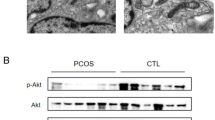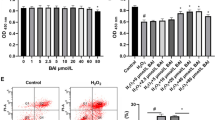Abstract
Diminished ovarian reserve (DOR) is characterized by the depletion of the ovarian pool, which leads to reductions in oocyte quality and quantity. Studies have suggested that ovarian reserve or ovarian aging is tightly related to apoptosis. However, the cell death mechanism is not comprehensively understood. Parthanatos, a type of poly [ADP-ribose] polymerase 1(PARP1)-dependent and apoptosis-inducing factor (AIF)-mediated cell death, plays a crucial role in various disorders. In the present study, we aimed to investigate whether parthanatos is involved in the pathogenesis of DOR. We recruited 40 patients (20 DOR patients and 20 normal ovarian reserve (NOR) patients) and examined PAR expression and AIF translocation in their isolated cumulus GCs (granulosa cells) by fluorescence microscopy. Our results demonstrated that PAR expression and AIF nuclear translocation were significantly higher in cumulus GCs of DOR patients, suggesting that PARP1-dependent cell death may be associated with DOR pathophysiology. Moreover, we tested the protective function of melatonin on hydrogen peroxide (H2O2)-induced parthanatos in human ovarian cancer (IGROV1) cells. Our results demonstrated that H2O2 treatment of IGROV1 cells led to excessive protein PARylation and AIF translocation into the nuclei. Melatonin effectively inhibits PARylation, blocks translocation of AIF into the nucleus, and consequently decreases the risk of parthanatos in cumulus GCs.








Similar content being viewed by others
Data Availability
The dataset analyzed during the study is available upon request from the corresponding author.
Abbreviations
- DOR:
-
diminished ovarian reserve
- AIF:
-
apoptosis-inducing factor
- PARP1:
-
dependent cell death (Poly(ADP-Ribose) polymerase 1)
- ROS:
-
reactive oxygen species
- IVF:
-
in vitro fertilization
- GCs:
-
granulosa cells
- SRCC:
-
Spearman rank correlation coefficient
- NOR:
-
normal ovarian reserve
- COC:
-
cumulus-oocyte complex
- FF:
-
follicular fluid
- AMH:
-
anti-Müllerian hormone
- GL:
-
granulosa lutein cell
- PAR:
-
poly(ADP-ribose)
References
Practice Committee of American Society for Reproductive, M. Diagnostic evaluation of the infertile female: a committee opinion. Fertil Steril. 2012;98(2):302–7.
Jamil Z, et al. Anti-Mullerian hormone: above and beyond conventional ovarian reserve markers. Dis Markers. 2016;2016:5246217.
Seidler EA, Moley KH. Metabolic determinants of mitochondrial function in oocytes. Semin Reprod Med. 2015;33(6):396–400.
Feuerstein P, et al. Genomic assessment of human cumulus cell marker genes as predictors of oocyte developmental competence: impact of various experimental factors. PLoS One. 2012;7(7):e40449.
Szafarowska M, Jerzak M. Ovarian aging and infertility. Ginekol Pol. 2013;84(4):298–304.
Liew SH, et al. Loss of the proapoptotic BH3-only protein BCL-2 modifying factor prolongs the fertile life span in female mice. Biol Reprod. 2014;90(4):77.
Jancar N, et al. Apoptosis, reactive oxygen species and follicular anti-Mullerian hormone in natural versus stimulated cycles. Reprod Biomed Online. 2008;16(5):640–8.
Seifer DB, et al. Apoptosis as a function of ovarian reserve in women undergoing in vitro fertilization. Fertil Steril. 1996;66(4):593–8.
Boucret L, et al. Relationship between diminished ovarian reserve and mitochondrial biogenesis in cumulus cells. Hum Reprod. 2015;30(7):1653–64.
Bencomo E, et al. Apoptosis of cultured granulosa-lutein cells is reduced by insulin-like growth factor I and may correlate with embryo fragmentation and pregnancy rate. Fertil Steril. 2006;85(2):474–80.
Cocchia N, et al. The effects of superoxide dismutase addition to the transport medium on cumulus-oocyte complex apoptosis and IVF outcome in cats (Felis catus). Reprod Biol. 2015;15(1):56–64.
Jang H, et al. Melatonin prevents cisplatin-induced primordial follicle loss via suppression of PTEN/AKT/FOXO3a pathway activation in the mouse ovary. J Pineal Res. 2016;60(3):336–47.
Sanchez AM, et al. Treatment with anticancer agents induces dysregulation of specific Wnt signaling pathways in human ovarian luteinized granulosa cells in vitro. Toxicol Sci. 2013;136(1):183–92.
David KK, et al. Parthanatos, a messenger of death. Front Biosci (Landmark Ed). 2009;14:1116–28.
Virag L, et al. Poly(ADP-ribose) signaling in cell death. Mol Aspects Med. 2013;34(6):1153–67.
Kilarkaje N, Al-Hussaini H, Al-Bader MM. Diabetes-induced DNA damage and apoptosis are associated with poly (ADP ribose) polymerase 1 inhibition in the rat testis. Eur J Pharmacol. 2014;737:29–40.
Agarwal A, et al. Potential biological role of poly (ADP-ribose) polymerase (PARP) in male gametes. Reprod Biol Endocrinol. 2009;7:143.
Tramontano F, Malanga M, Quesada P. Differential contribution of poly(ADP-ribose)polymerase-1 and -2 (PARP-1 and -2) to the poly(ADP-ribosyl)ation reaction in rat primary spermatocytes. Mol Hum Reprod. 2007;13(11):821–8.
Andrabi SA, et al. Poly(ADP-ribose) (PAR) polymer is a death signal. Proc Natl Acad Sci U S A. 2006;103(48):18308–13.
Wang Y, et al. Poly(ADP-ribose) (PAR) binding to apoptosis-inducing factor is critical for PAR polymerase-1-dependent cell death (parthanatos). Sci Signal. 2011;4(167):ra20.
Basello DA, Scovassi AI. Poly(ADP-ribosylation) and neurodegenerative disorders. Mitochondrion. 2015;24:56–63.
Aredia F, Scovassi AI. Involvement of PARPs in cell death. Front Biosci (Elite Ed). 2014;6:308–17.
Fatokun AA, Dawson VL, Dawson TM. Parthanatos: mitochondrial-linked mechanisms and therapeutic opportunities. Br J Pharmacol. 2014;171(8):2000–16.
Mashimo M, Kato J, Moss J. ADP-ribosyl-acceptor hydrolase 3 regulates poly (ADP-ribose) degradation and cell death during oxidative stress. Proc Natl Acad Sci U S A. 2013;110(47):18964–9.
El-Domyati MM, et al. The expression and distribution of deoxyribonucleic acid repair and apoptosis markers in testicular germ cells of infertile varicocele patients resembles that of old fertile men. Fertil Steril. 2010;93(3):795–801.
Chen H, et al. Association of common SNP rs1136410 in PARP1 gene with the susceptibility to male infertility with oligospermia. J Assist Reprod Genet. 2014;31(10):1391–5.
Meyer-Ficca ML, et al. Disruption of poly(ADP-ribose) homeostasis affects spermiogenesis and sperm chromatin integrity in mice. Biol Reprod. 2009;81(1):46–55.
Wei Q, Ding W, Shi F. Roles of poly (ADP-ribose) polymerase (PARP1) cleavage in the ovaries of fetal, neonatal, and adult pigs. Reproduction. 2013;146(6):593–602.
Macchi MM, Bruce JN. Human pineal physiology and functional significance of melatonin. Front Neuroendocrinol. 2004;25(3-4):177–95.
Fernando S, Rombauts L. Melatonin: shedding light on infertility?--a review of the recent literature. J Ovarian Res. 2014;7:98.
Liang S, et al. Effect and possible mechanisms of melatonin treatment on the quality and developmental potential of aged bovine oocytes. Reprod Fertil Dev. 2016.
Nishihara T, et al. Oral melatonin supplementation improves oocyte and embryo quality in women undergoing in vitro fertilization-embryo transfer. Gynecol Endocrinol. 2014;30(5):359–62.
Seko LM, et al. Melatonin supplementation during controlled ovarian stimulation for women undergoing assisted reproductive technology: systematic review and meta-analysis of randomized controlled trials. Fertil Steril. 2014;101(1):154–61 e4.
Batioglu AS, et al. The efficacy of melatonin administration on oocyte quality. Gynecol Endocrinol. 2012;28(2):91–3.
Eryilmaz OG, et al. Melatonin improves the oocyte and the embryo in IVF patients with sleep disturbances, but does not improve the sleeping problems. J Assist Reprod Genet. 2011;28(9):815–20.
Unfer V, et al. Effect of a supplementation with myo-inositol plus melatonin on oocyte quality in women who failed to conceive in previous in vitro fertilization cycles for poor oocyte quality: a prospective, longitudinal, cohort study. Gynecol Endocrinol. 2011;27(11):857–61.
Tamura H, et al. Melatonin and the ovary: physiological and pathophysiological implications. Fertil Steril. 2009;92(1):328–43.
Tamura H, et al. Oxidative stress impairs oocyte quality and melatonin protects oocytes from free radical damage and improves fertilization rate. J Pineal Res. 2008;44(3):280–7.
Batnasan E, et al. 17-beta estradiol inhibits oxidative stress-induced accumulation of AIF into nucleolus and PARP1-dependent cell death via estrogen receptor alpha. Toxicol Lett. 2015;232(1):1–9.
Tilly JL. Commuting the death sentence: how oocytes strive to survive. Nat Rev Mol Cell Biol. 2001;2(11):838–48.
Virag L. Structure and function of poly(ADP-ribose) polymerase-1: role in oxidative stress-related pathologies. Curr Vasc Pharmacol. 2005;3(3):209–14.
Virag L, Szabo C. The therapeutic potential of poly(ADP-ribose) polymerase inhibitors. Pharmacol Rev. 2002;54(3):375–429.
Qian H, et al. Oocyte numbers in the mouse increase after treatment with 5-aminoisoquinolinone: a potent inhibitor of poly(ADP-ribosyl)ation. Biol Reprod. 2010;82(5):1000–7.
Lin'kova NS, Katanugina AS, Khavinson V. Expression of AIF and CGRP markers in pineal gland and thymus during aging. Adv Gerontol. 2011;24(4):601–5.
Vilser C, et al. The variable expression of lectin-like oxidized low-density lipoprotein receptor (LOX-1) and signs of autophagy and apoptosis in freshly harvested human granulosa cells depend on gonadotropin dose, age, and body weight. Fertil Steril. 2010;93(8):2706–15.
Yu SW, et al. Mediation of poly(ADP-ribose) polymerase-1-dependent cell death by apoptosis-inducing factor. Science. 2002;297(5579):259–63.
Daugas E, et al. Apoptosis-inducing factor (AIF): a ubiquitous mitochondrial oxidoreductase involved in apoptosis. FEBS Lett. 2000;476(3):118–23.
Oh KH, et al. Control of AIF-mediated cell death by antagonistic functions of CHIP ubiquitin E3 ligase and USP2 deubiquitinating enzyme. Cell Death Differ. 2011;18(8):1326–36.
Aredia F, Scovassi AI. Poly(ADP-ribose): a signaling molecule in different paradigms of cell death. Biochem Pharmacol. 2014;92(1):157–63.
Joshi A, et al. PARP1 during embryo implantation and its upregulation by oestradiol in mice. Reproduction. 2014;147(6):765–80.
Zhang F, et al. Poly(ADP-ribose) polymerase 1 is a key regulator of estrogen receptor alpha-dependent gene transcription. J Biol Chem. 2013;288(16):11348–57.
Song C, et al. Melatonin improves age-induced fertility decline and attenuates ovarian mitochondrial oxidative stress in mice. Sci Rep. 2016;6:35165.
Chuffa LG, et al. Apoptosis is triggered by melatonin in an in vivo model of ovarian carcinoma. Endocr Relat Cancer. 2016;23(2):65–76.
Meng X, et al. Overexpression of septin-7 inhibits melatonin-induced cell apoptosis in human fetal osteoblastic cells via suppression of endoplasmic reticulum stress. Mol Med Rep. 2018;17(3):4817–22.
Yan G, et al. Melatonin antagonizes oxidative stress-induced mitochondrial dysfunction in retinal pigmented epithelium cells via melatonin receptor 1 (MT1). J Toxicol Sci. 2018;43(11):659–69.
Acknowledgments
This study was supported by the clinic big data research funding of Central South University. We would like to thank the staff of Reproductive Medicine Center, Xiang-Ya Hospital, Central South University, Professor Xueqing Ba (Institute of Genetics and Cytology, Northeast Normal University, China), Dr Saeed Ahmad (English Language Institute, Jazan University, KSA and Dr Khishigt Dandarchuluun ( Department of Statistics and Econometrics, National University of Mongolia, Mongolia).
Funding
This project supported by the National Natural Science Foundation of China (Grant number #81571507, (http://nsfc.gov.cn/)) and the research foundation of the Chinese Scholarship Counsel (PhD scholarship for Dr. Enkhzaya Batnasan).
Author information
Authors and Affiliations
Contributions
EB performed sample collection and experiments, conceived the study idea and design, performed the statistics analyses, drafted the manuscript, and was a major contributor in writing the manuscript. QZ and JZ contributed substantially to the interpretation of the data and provided statistical support. LY supervised and coordinated the study and design, contributed to the interpretation of the data, and revised the manuscript. All authors confirmed the final version of the manuscript.
Corresponding author
Ethics declarations
Competing Interests
The authors declare that they have no competing interests.
Ethical Approval
This study was reviewed and approved by Ethics Committee of Xiang-Ya Hospital, Central South University. The research was also approved through Chinese Clinical Trial (registration number #ChiCTR-OOC-16008391). Written informed consent was obtained from each patient before sample collection.
Rights and permissions
About this article
Cite this article
Batnasan, E., Xie, S., Zhang, Q. et al. Observation of Parthanatos Involvement in Diminished Ovarian Reserve Patients and Melatonin’s Protective Function Through Inhibiting ADP-Ribose (PAR) Expression and Preventing AIF Translocation into the Nucleus. Reprod. Sci. 27, 75–86 (2020). https://doi.org/10.1007/s43032-019-00005-8
Received:
Accepted:
Published:
Issue Date:
DOI: https://doi.org/10.1007/s43032-019-00005-8




